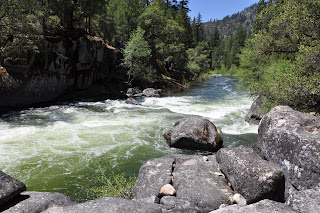
With a decent snowfall and early May rains, the Mokelumne River's really flowing this spring. Salt Springs Dam may spill soon. If it doesn't, that will only be because PG&E is releasing a huge amount of water into the river to keep the flow high and temperature cold (which has to do with foothill yellow-legged frogs, but I'll spare you the details).
If you've never seen the North Fork running high, now's a good time to do it. Ellis Road, Panther Creek and Tiger Creek Road are all open (see maps).
Downstream at Highway 49, the Mokelumne's Electra-Middle Bar run is also flowing fast and high. Normally the run is a forgiving, friendly river, a nice float trip with some fun rapids, plus a challenging, bouncy Class III rapid below the Highway 49 Bridge. People come from all over to learn to kayak there. In high flows, it's another river entirely -- definitely not a place for beginners.
We ran Electra-Middle Bar yesterday in a flotilla of four large rafts captained by experienced guides. It was a great trip, if a short one: It only took us 40 minutes to get from the put-in to the Middle Bar takeout. Normally the trip is close to two hours long.
During the safety talk before we headed downstream, our lead guide, David "Chicken" Nesmith, charged us with one main task: "stay in the boat." With the high flows, cold snow-melt water, and many "strainers" along the river's edges, the river's no place for a swim right now. Visualize trees and shrubs as a colander and rafters as spaghetti and you'll understand what strainers are all about.
Before we headed out, we had to rig boats, send vehicles to the Middle Bar takeout, and have lunch. As we went through these steps, we talked to other folks coming down to the river. I met one threesome of local men who are very familiar with and love the Mokelumne. They recognized that their skills were no match for the river at this flow.
And then there was another group. These folks had three rafts, none of which was really appropriate for whitewater river use. Two were little more than pool toys. BLM river ranger Scott was there, and took time to warn the would-be rafters about the dangers of the river at this high flow, especially considering their obvious lack of expertise and appropriate gear.
But these "we know the river" folks headed downstream anyway. All three boats flipped at the first little rapid. Scott was following them on land and went down to help, but a good Samaritan visiting the river reached them first. Everyone was OK, but we spotted one of the boats a good ways downstream, stuck in the trees. Truth is, they were very lucky to crash and burn early on before things got sticky.
We had a great trip, and a more successful one. It was quick, and pretty exciting at times (especially for the two people who briefly poured out of the rafts and into the Devil's Toilet Bowl rapid). We paddled hard. But we also had time to enjoy this beautiful river right here in our backyard.
The entire Middle Bar reach and nearly a mile of the Electra run would be drowned if East Bay MUD were to expand Pardee Reservoir as proposed. Let's hope that all of the foothill outcry, and continued good work by Foothill Conservancy and others, keeps that from ever coming to pass.
It's time to secure National Wild and Scenic River designation for the Mokelumne so that in the future, other folks like those in our group can experience the river first-hand, and in doing so, better understand our nation's history and culture as well as its environment.